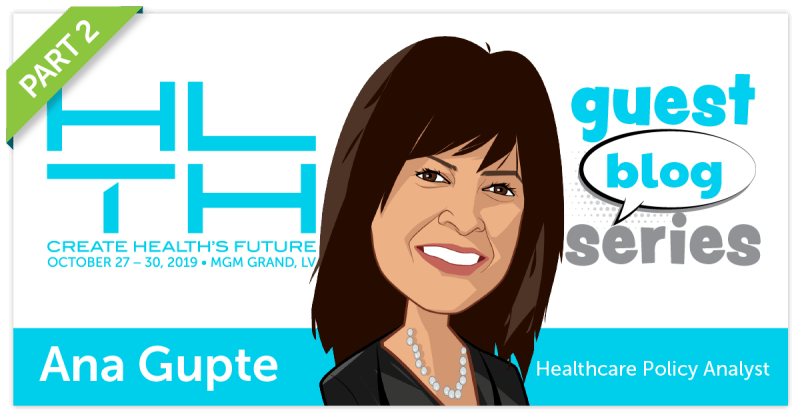Sep 25, the Kaiser Family Foundation annual survey of Employers reported that the cost of Health Insurance has hit a high of over $20000 a year for a working American family. Average annual deductibles of $1655 annual are 2x that of a decade ago. And workers at lower wage employers are half as likely to have access to affordable coverage.
The Sep 12 Democratic Primary debates had Healthcare front and center with the left advocating for single Payor Medicare for All that costs $30 Trillion over a decade as the answer to affordability.
Separating the key facts from fiction seems in order. I wrote a blog post recently about “What’s Working; What Needs Fixing.” As I prepare to moderate the very interesting panel “What’s at Stake?” at HLTH October 28, it’s worth taking a deeper look at US Healthcare spend and trend. Ultimately, addressing the healthcare cost conundrum is the basis of improving access and quality for working Americans.
The facts speak for themselves. We are making a great deal of progress through public private partnerships on moderating utilization of healthcare products and services. Middlemen are not the driver of the cost problem. Rather, the crux of the cost conundrum is two-fold. First unit price inflation, especially the burden borne by employer sponsored insurance. Second, re- directing the flow of subsidies within the ecosystem and plugging the hole to improve affordability for working Americans.
The Facts
The 85% of medical spend in that $3.8 T Healthcare economy has meaningfully moderated as utilization has subsided.
The US healthcare economy is now at $3.8T annual spend and ~18% of the GDP. And yes, healthcare spend per capita of over $10000 per year is higher than other OECD countries. What are the key cost drivers in the employer sponsored healthcare economy for working Americans?
The bulk of healthcare spend (80-85%) is deployed toward actual medical, pharmacy and behavioral costs for Americans. Per the latest Milliman Medical Index report in 2019, for working Americans, Hospital costs comprise close to ~50% of the total medical costs split.
between Inpatient costs at 19% and Outpatient costs at 29% of spend. Physician costs represent the other 30% and Pharmaceutical costs are 20% of the medical spend.
Per Milliman as well, Healthcare costs are increasing at a much slower pace, by historical standards. The cost of healthcare for a family of four with employer benefits has moderated from the low double digits in the early 2000s to very low single digits in 2018 and 2019. Back in the early 2000s, healthcare expenses were growing by 10% a year. Now, the growth rates are at record-low levels as costs grew 2.9%. Drug costs for a working American family in 2019 increased by only 2.1% in 2019, compared to solid double digits in the early 2000s.
Unit price inflation Is the leading driver of medical cost growth. Fixes can improve affordability for working Americans.
The leading driver of trend increases for 2019 continues to be unit price inflation for hospital services. Price Inflation Is 4x the growth in utilization for Hospitals which represent 50% of the overall spend. Even for Prescription drugs, unit price inflation is more than 50% greater than the growth in spend from the volume of drugs consumed by Americans, per the latest report from the Employer Benefits Consulting Firm Segal.
Transparency in Hospital pricing is key. In-network discounts, impactful policies such as Site Neutral payments as have been proposed by CMS and bipartisan solutions to address surprise medical billing must make it to the finish line, without invoking judicial loopholes. Drug pricing reform drafts from the House and the Senate Finance Committee need to move forward.
Flow of Subsidies can be re-directed or means tested Supplemental policies created to reduce the burden on working Americans
Employers subsidize healthcare for Government programs of Medicare and Medicaid. America more broadly subsidizes innovation in Biopharma therapies for the rest of the world. While this places a burden on working Americans, eliminating employer-sponsored insurance entirely for a $30 Trillion price tag is not the answer. Rather, targeted means tested Federally funded supplemental policies could be created to improve premium subsidies and plug the out- of-pocket cost burden for working Americans. Drug manufacturer rebates, and employer premium subsidies could be carefully allocated to keep the burden on working Americans, particularly in the lower wage brackets in mind.
Fiction
It is not the Middlemen.
In actuality, the profit pool for middlemen is a very small fraction of US healthcare costs. Post ObamaCare, 80-85% of the US Healthcare Dollar goes toward medical spend, which has capped profit margins for health plans. The total estimated profit pool for the health insurance and pharmacy benefits manager (PBM) industry combined is $50 B or just ~1.5% of the entire healthcare economy across all the segments they serve: Medicare Advantage, Employer- Sponsored Insurance, Managed Medicaid, TriCare and Individual/Exchanges.
The now largely vertically integrated health plan and PBM administrative cost base is deployed toward essential functions of claims payment and moderating consumption, while improving outcomes. These essential functions will need to be performed by the US Government, with an infrastructure that is not in place and could take decades if it can be rebuilt at all.
Americans in recent surveys have overwhelmingly said they want to keep their current health insurance, with half the country getting their coverage from their employers, so completely dismantling the employer benefits markets is not the answer.
Policy makers can work with the private sector to build on the successes to date
Pubic private partnerships are at the heart of American healthcare. Value based care is finally being embraced not just by private payors but also CMS and the Center for Medicare and Medicaid Innovation (CMMI). We are even seeing the beginnings of biopharma contracting focusing on clinical outcomes in partnership with health plans and employers.
The integration of medical, behavioral and pharmaceutical spend that looks holistically at drivers to lower total costs has been embraced by the private sector through vertical consolidation, and through strategic partnerships.
Technology is becoming an enabler. It is driving the integration of data across claims, and clinical data as well as through remote patient monitoring, Technology is enabling care for those who need it in the setting they need it most; in store, in retail friendly settings, at home, virtually and for remote rural Populations. The efforts by innovative players to reshape the antiquated technology backbone so claims adjudication and payment becomes more efficient is now on the horizon, reducing the administrative cost burden.
While campaign rhetoric is dominating the headlines, what Americans need are practical bipartisan solutions. Much remains to be done. United the public and private sector can make healthcare better for all Americans.

